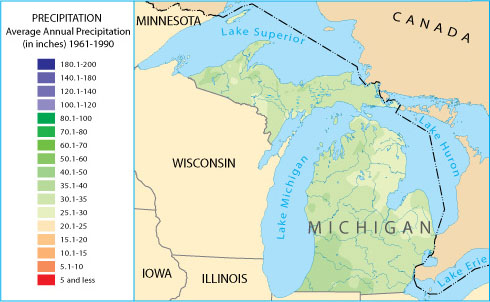|

CREATE AND INTERPRET MAPS.You learned to use data and a legend to fill in an outline map in lesson 1. This objective will have you apply this skill again in order to allow you to feel more comfortable with this process. You will color the map of Michigan to illustrate the population by county using the following legend and information. Use Figure 4.6.6 as an example of how this should be done. You will use this map to answer questions later in the lesson and in the Speedback assignment. You can open a printable legend if you would like to mark the colors next to the names of the counties before color- coding the map.
Color-code the counties on the map using data and legend above. Click a county and you will see the name of that county in larger text in the upper right hand corner of your map exercise, where it says "selected county". After you click the county, check the chart and legend above to find out the number of people per square mile and color the county accordingly. Once you have colored the entire map, click the check button. If the colors are correct, they will remain. If the colors are wrong, they will be erased. Once your map is right, print it so that you can use it for your Speedback assignment. If the map is difficult to read, you can click here to open the map in a pop up window. When you are done working with the map and after you print it, simply close the popup.
Now compare the colored population map to the precipitation map below.
Using the population and precipitation maps of Michigan, answer the following questions before reading ahead for the answers. a. Do the areas of highest population in Michigan also receive the most precipitation? b. Do all of Michigan's coastlines have similar population levels?
c. Find South Dakota and Michigan in Figure 4.2.1. How do you think the average daily temperatures of the two states compare? Click Here to Check Your Answers a. Most areas of Michigan receive
adequate rainfall; therefore, precipitation is adequate for settlement in almost
any area of Michigan. Footnotes 
| |||||||||||||||||||||||||||||||||||||||||||||||||||||||||||||||||||||||||||||
About Us | Terms of Use | Contact Us | Partner with Us | Press Release | Sitemap | Disclaimer | Privacy Policy
©1999-2011 OpenLearningWorld . com - All Rights Reserved



